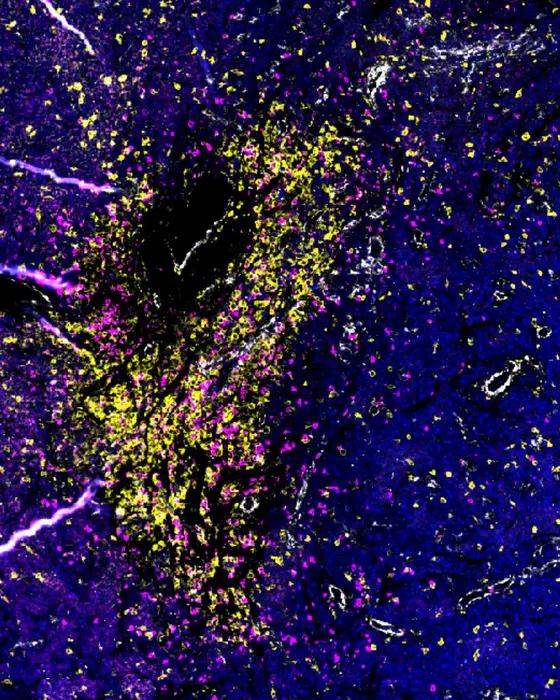The incurable bone marrow cancer “multiple myeloma” often develops unnoticed in the bone marrow over decades. In advanced stages, lesions form that can destroy the bone and spread to other parts of the body. An interdisciplinary team from the Myeloma Center at Heidelberg University Hospital (UKHD), the DKFZ, the Berlin Institute of Health at Charité (BIH), the Max Delbrück Center (MDC) and the Queen Mary University,London, have been investigating what happens in these lesions when the myeloma cells first break through the bone. The researchers discovered that the tumor cells develop a dramatic diversity when leaving the bone marrow, which also affects the immune cells in the cancer foci. The new findings could contribute to more precise diagnostics and therapy.
When the tumor cells leave the bone, they find themselves in a completely different environment with different environmental conditions. “We suspect that this diversity helps the cancer cells adapt to survival outside the bone, enabling them to spread to other areas of the body,” says Niels Weinhold, head of Translational Myeloma Research at the UKHD.
Using innovative technology, the team also examined for the first time how the immune system reacts to this “outbreak” of cancer cells from the bone. They discovered significant changes in the type and number of immune cells in the area of the cancerous lesions. For example, certain immune cells, known as T cells, had very different receptors and surface molecules in the foci outside the bone – a possible adaptation to the newly emerged heterogeneity of the tumor cells. “There seems to be a co-evolution between tumor and immune cells, in which both sides react to changes in the other,” says Simon Haas, a precision medicine specialist at the Berlin Institute of Health's (BIH), Max Delbrück Center (MDC), and Queen Mary University. The researchers hypothesize that this intensified interaction between the immune system and the cancer may both promote and hinder the fight against the disease. The team is currently investigating which factors contribute positively and which negatively to this interaction.
For their analyses, the international team examined material from multiple myeloma lesions at various body sites either by means of image-guided biopsies or during operations on fracture-prone or already broken bones. Modern single-cell analyses and spatial multi-omics techniques were used. These methods allow the simultaneous investigation of various properties of a cell in the tissue, taking into account its exact position in the tissue.
The results could influence the diagnosis and therapy of myeloma in the future: Currently, samples for diagnosis are usually taken from the iliac crest of patients. However, since the study has now shown that cancer and immune cells in bone openings differ significantly from those in the iliac crest, these sites may be better suited for sample collection and allow a more precise assessment of the disease and possible adjustment of therapy.
The first authors of the article are Alexandra Poos, Raphael Lutz and Lukas John, Medical Faculty Heidelberg at UKHD and DKFZ, and Llorenç Solé Boldo from MDC, BIH and Queen Mary University.
Lutz R, Poos AM, Solé-Boldo L, John L, Wagner J, Prokoph N, Baertsch AM, Vonficht D, Palit S, Brobeil A, Mechtersheimer G, Hildenbrand N, Hemmer S, Steiger S, Horn S, Pepke W, Spranz DM, Rehnitz C, Sant P, Mallm JP, Friedrich MJ, Reichert P, Huhn S, Trumpp A, Rippe K, Haghverdi L, Fröhling S, Müller-Tidow C, Hübschmann D, Goldschmidt H, Willimsky G, Sauer S, Raab MS, Haas S, Weinhold N.. Bone marrow breakout lesions act as key sites for tumor-immune cell diversification in multiple myeloma.
Sci. Immunol., 2025. doi: 10.1126/sciimmunol.adp6667
Source: Press release of the UKDH

